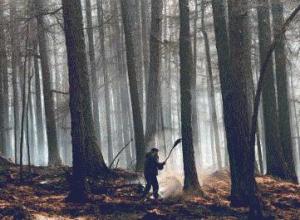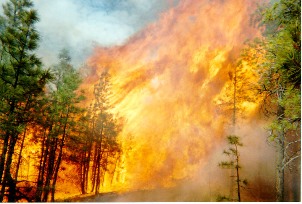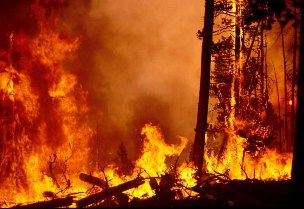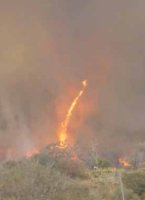







Convection has the largest impact on the spread of a wildland fire. Heat rising in the smoke column can spread the fire in many ways. Burning materials, such as firebrands, may be carried by the resulting air current and deposited in other locations thus starting new fires to be dealt with. Fuels in front of the head of the fire itself can start to preheat from convection if weather conditions and topography are just right. This phenomenon explains, in part, why fires tend to move up hill and/or with the wind. Convection is also one of the driving factors that can cause a crown fire which will be discussed later (Teie 152).
Although not as significant of impact as convection, radiation also has the capability of preheating fuels which can cause unburned fuels across a fire line to ignite. Essentially the fire "jumps" the fire line. Finally, conduction has the least impact on transporting a wildland fire since wood is a poor conductor. However, it cannot be discounted completely since a fire can be transported through roots systems or other means that are less obvious to notice (Teie 153-154).
As mentioned earlier, wildland fire can spread through an effect known as spotting where burning material is transported by convection away from the main fire source. These materials, known as firebrands, can also be transported by "popping," wind, and gravity. Popping is a short range problem that is caused when a small amount of heated steam explodes, sending small pieces of burning wood away from the initial source. Wind can transport firebrand much the same way as convection. Combined with convection, this can be an ugly combination transported firebrand a large distance away from the main fire source. Finally, gravity, coupled with the right topography such as hills and slopes, can cause burning material to roll down hill, especially round objects such as logs and pine cones (Teie 154-156).

The rate that energy is released in the form of heat during combustion is referred to as the fire intensity. Two methods are used to evaluate the fire intensity. The first method is the fireline intensity which is the "amount of heat released per foot of fire front per second (Teie 158)." The flame length is determined by measuring the distance between the average flame tip and the base of the fire in the center of the fire zone. Several factors affect fire intensity. These factors are fuel loading, arrangement or density of fuels, moisture content of the fuel, the slope of the terrain and wind speed. A fire will burn less intense in conditions of dense fuels and/or fuels with a high moisture content (Teie 158-159).
The rate of fire spread is influenced by the fire intensity, wind speed, slope, fuel type changes, natural or manmade barriers, and spotting. The rate of spread will increase as the fire intensity increases. With an increase in wind, the convection associated with the fire will start to lean in the direction of the wind causing the fire to move faster. A change in fuel type will also affect the fire spread depending on the type of fuels that the fire reaches. Barriers, either natural or manmade, can also slow a fire's progression or change the direction a fire will continue to travel. A fire that generates a higher occurrence of spot fires will spread quicker than one that generates fewer spot fires (Teie 159).
Three factors influence the direction in which a fire will spread. These factors are wind, slope, and the condition of the fuel. Wind will push a fire in the direction the wind is traveling. This will bring the heat source closer to the fuel through conduction and radiation. Fire will tend to travel up hill for the same reason because the fuel source is closer to the heat source than it would be on flat ground. Finally the condition that the fuel is in can determine the direction of the fire spread. Drier fuels will ignite quicker causing the fire to travel faster in that direction (Teie 162).

Extreme fire behavior refers to the phenomenon when fire takes on a life of its own as shown in the above photo. This behavior is most readily seen in the large scale campaign fires that can consume many firefighters and a multitude of resources. It is under these conditions that firefighters face the greatest safety risk in the field. Extreme fire behavior is characterized by a rapid rate of spread, high fire intensity, heavy spotting, and the formation of crown fires. There are several indicators that can be precursors to extreme fire behavior.
The smoke column is one of the best indicators of what a fire is doing at a given time since it can usually be easily observed from a distance. A smoke column that is leaning forward indicates a wind driven fire with short range spotting. Long range spotting may begin to occur when a sheared smoke column is present which indicates strong upper level winds. A white capped column that rises a considerable height is considered to be well developed. This column indicates potential intensive burning conditions and unpredictable fire behavior (Teie 219).
Torching is the "burning of the foliage of a single tree, or a small group of trees, from the bottom up (National Wildlife Coordination Group 344)." Trees will begin to torch when the relative humidity starts to drop. When trees begin to torch, the fire conditions are getting worse (Teie 219).

An indicator of unstable air conditions is the fire whirl. This means that the fire may start to go vertical creating a strong convection column, a possible precursor for a crown fire.

Crown fires can exist in three stages: passive, active, and independent. These fires usually begin with the torching of a single tree or bush. From this point, the fire can then move across the treetops or canopy. The passive crown fire, as shown below, may involve on one or a few trees and is usually short lived causing no serious threat. An active crown fire, although still dependant on the surface fire, moves with greater effectiveness through the treetops. An active crown fire should be approached with greater caution. Independent of the surface fire, the independent crown fire is the most dangerous of the three stages since it can sustain itself. Since it does not rely on the surface fire, virtually nothing can be done to stop this event (Teie 224). Luckily they do not occur often.

Home| Fire Basics| Wildland Basics| Fire Behavior| Methods of Attack| References